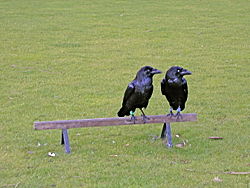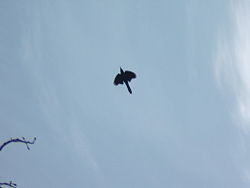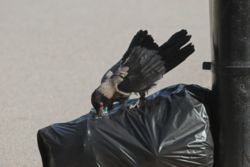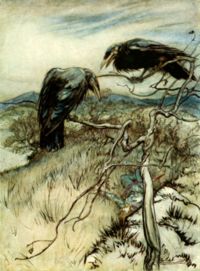Crow
2008/9 Schools Wikipedia Selection. Related subjects: Birds
| Crow | ||||||||||||
|---|---|---|---|---|---|---|---|---|---|---|---|---|
 Common Raven (Corvus corax)
|
||||||||||||
| Scientific classification | ||||||||||||
|
||||||||||||
| Species | ||||||||||||
|
See text. |
The true crows are large passerine birds that comprise the genus Corvus in the family Corvidae. Ranging in size from the relatively small pigeon-sized jackdaws (Eurasian and Daurian) to the Common Raven of the Holarctic region and Thick-billed Raven of the highlands of Ethiopia, the 40 or so members of this genus occur on all temperate continents (except South America) and several offshore and oceanic islands (including Hawaii).
The crow genus makes up a third of the species in the corvid family. Other corvids include rooks and jays. Crows appear to have evolved in Asia from the corvid stock, which had evolved in Australasia.
Systematics
The genus was originally described by Linnaeus in his 18th century work Systema Naturae. The name is derived from the Latin corvus meaning "raven". The type species is the Common Raven (Corvus corax); others named in the same work include the Carrion Crow (C. corone), the Hooded Crow (C. cornix), the Rook (C. frugilegus), and the Jackdaw (C. monedula).
There is no good systematic approach to the genus at present. Generally, it is assumed that the species from a geographical area are more closely related to each other than to other lineages, but this is not necessarily correct. For example, while the Carrion/Collared/House Crow complex is certainly closely related to each other, the situation is not at all clear regarding the Australian/Melanesian species. Furthermore, as many species are similar in appearance, determining actual range and characteristics can be very difficult, such as in Australia where the five (possibly six) species are almost identical in appearance.
The fossil record of crows is rather dense in Europe, but the relationships among most prehistoric species is not clear. Jackdaw-, crow- and raven-sized forms seem to have existed since long ago and crows were regularly hunted by humans up to the Iron Age, documenting the evolution of the modern taxa. American crows are not as well-documented.
A surprisingly high number of species have become extinct after human colonization; the loss of one prehistoric Caribbean crow could also have been related to the last ice age's climate changes.
Species

Australian and Melanesian species
- Australian Raven C. coronoides
- Forest Raven C. tasmanicus
- Relict Raven C. (t.) boreus
- Little Crow C. bennetti
- Little Raven C. mellori
- Torresian Crow C. orru
- New Caledonian Crow C. moneduloides
- Long-billed Crow C. validus
- White-billed Crow C. woodfordi
- Bougainville Crow C. meeki
- Brown-headed Crow C. fuscicapillus
- Grey Crow C. tristis
- New Ireland Crow, Corvus sp. ( prehistoric)
New Zealand species
- Chatham Islands Raven, C. moriorum ( prehistoric)
- New Zealand Raven, C. antipodum ( prehistoric)
Pacific island species
- Mariana Crow, C. kubaryi
- Hawaiian Crow or ‘Alala C. hawaiiensis ( extinct in the wild, formerly C. tropicus)
- High-billed Crow, C. impluviatus ( prehistoric)
- Robust Crow, C. viriosus ( prehistoric)
Tropical Asian species
- Slender-billed Crow C. enca
- Piping Crow C. typicus
- Banggai Crow C. unicolor (possibly extinct)
- Flores Crow C. florensis
- Collared Crow C. torquatus
- Daurian Jackdaw C. dauricus
- House Crow C. splendens
- Large-billed Crow C. macrorhynchos
- Jungle Crow C. (m.) levaillantii
Eurasian and North African species
- Brown-necked Raven C. ruficollis
- Somali Crow or Dwarf Raven C. edithae
- Fan-tailed Raven C. rhipidurus
- Jackdaw C. monedula
- Rook C. frugilegus
- Hooded Crow C. cornix
- Mesopotamian Crow, C. (c.) capellanus
- Carrion Crow C. corone
- Carrion Crow (Eastern subspecies) C. (c.) orientalis
- Corvus larteti (fossil: Late Miocene of France, or C Europe?)
- Corvus pliocaenus (fossil: Late Pliocene –? Early Pleistocene of SW Europe)
- Corvus antecorax (fossil: Late Pliocene/Early – Late Pleistocene of Europe; may be subspecies of Corvus corax
- Corvus betfianus (fossil)
- Corvus praecorax (fossil)
- Corvus simionescui (fossil)
- Corvus fossilis (fossil)
- Corvus moravicus (fossil)
- Corvus hungaricus (fossil)
Holarctic species
- Common Raven C. corax (see also next section)
- Pied Raven, C. c. varius morpha leucophaeus (an extinct colour variant)
North and Central American species
- American Crow C. brachyrhynchos
- Western Raven C. (corax) sinuatus
- Chihuahuan Raven C. cryptoleucus
- Fish Crow C. ossifragus
- Northwestern Crow C. caurinus
- Tamaulipas Crow C. imparatus
- Sinaloan Crow C. sinaloae
- Jamaican Crow C. jamaicensis
- White-necked Crow C. leucognaphalus
- Palm Crow C. palmarum
- Cuban Crow C. nasicus
- Puerto Rican Crow C. pumilis ( prehistoric; possibly a subspecies of C. nasicus/palmarum)
- Corvus galushai (fossil: Big Sandy Late Miocene of Wickieup, USA)
- Corvus neomexicanus (fossil: Late Pleistocene of Dry Cave, USA)
Tropical African species
- Cape Crow C. capensis
- Pied Crow C. albus
- Somali Crow or Dwarf Raven C. edithae
- Thick-billed Raven C. crassirostris
- White-necked Raven C. albicollis
In addition to the prehistoric forms listed above, some extinct chronosubspecies have been described. These are featured under the respective species accounts.
Crows and Humans
Certain species have been considered pests; the Common Raven, Australian Raven and Carrion Crow have all been known to kill weak lambs as well as eating freshly dead corpses probably killed by other means. Rooks have been blamed for eating grain in the UK and Brown-necked Raven for raiding date crops in desert countries.
Hunting
In the United States it is legal to hunt crows in all states usually from around August to the end of March and anytime if they are causing a nuisance or health hazard. There is no bag limit when taken during the "crow hunting season." According to the US Code of Federal Regulations, crows may be taken (i.e., shot) without a permit in certain circumstances. USFWS 50 CFR 21.43 (Depredation order for blackbirds, cowbirds, grackles, crows and magpies) states that a Federal permit is not required to control these birds "when found committing or about to commit depredations upon ornamental or shade trees, agricultural crops, livestock, or wildlife, or when concentrated in such numbers and manner as to constitute a health hazard or other nuisance," provided
- that none of the birds killed or their parts are sold or offered for sale,
- that anyone exercising the privileges granted by this section shall permit any Federal or State game agent free and unrestricted access over the premises where the operations have been or are conducted and will provide them with whatever information required by the officer, and
- that nothing in the section authorizes the killing of such birds contrary to any State laws and that the person needs to possess whatever permit as may be required by the State.
In the UK, the crow is considered a pest and under certain conditions can be shot under a number of general licenses issued by DEFRA.
In Australia it is illegal to kill native birds.
Evolution
They appear to have evolved in central Asia and radiated out into North America, Africa, Europe, and Australia.
The latest evidence appears to point towards an Australasian origin for the early family (Corvidae) though the branch that would produce the modern groups such as jays, magpies and large predominantly black Corvus. Crows had left Australasia and were now developing in Asia. Corvus has since re-entered Australia (relatively recently) and produced five species with one recognized sub-species.
Behaviour
Calls
Crows make a wide variety of calls or vocalizations. Whether the crows' system of communication constitutes a language is a topic of debate and study. Crows have also been observed to respond to calls of other species; this behaviour is presumably learned because it varies regionally. Crows' vocalizations are complex and poorly understood. Some of the many vocalizations that crows make are a "caw", usually echoed back and forth between birds, a series of "caws" in discrete units, counting out numbers, a long caw followed by a series of short caws (usually made when a bird takes off from a perch), an echo-like "eh-aw" sound, and more. These vocalizations vary by species, and within each species vary regionally. In many species, the pattern and number of the numerical vocalizations have been observed to change in response to events in the surroundings (i.e. arrival or departure of crows). Crows can hear sound frequencies lower than those that humans can hear, which complicates the study of their vocalizations.
Loud, throaty "caw-aw-ah"'s are usually used to indicate hunger or to mark territory. When defending a nest site or food, crows will usually enlarge their crest feathers and hunch their shoulders to increase their size. Softer, gurgling sounds have also been observed as a sort of beckoning call, or a call of affection. These noises are emitted from within the throat of the bird, much like a cat's purring.
Intelligence
As a group, the crows show remarkable examples of intelligence, and Aesop's fable of The Crow and the Pitcher shows that humans have long viewed the crow as an intelligent animal. Crows and ravens often score very highly on intelligence tests. Certain species top the avian IQ scale. Crows in the northwestern U.S. (a blend of Corvus brachyrhynchos and Corvus caurinus) show modest linguistic capabilities and the ability to relay information over great distances, live in complex, hierarchic societies involving hundreds of individuals with various "occupations", and have an intense rivalry with the area's less socially advanced ravens. Wild hooded crows in Israel have learned to use bread crumbs for bait-fishing. Crows will engage in a kind of mid-air jousting, or air-" chicken" to establish pecking order. One species, the New Caledonian Crow, has recently been intensively studied because of its ability to manufacture and use its own tools in the day-to-day search for food, including dropping seeds into a heavy trafficked street and waiting for a car to crush them open. On October 5, 2007, researchers from the University of Oxford, England presented data acquired by mounting tiny video cameras on the tails of New Caledonian Crows. It turned out that they use a larger variety of tools than previously known, plucking, smoothing and bending twigs and grass stems to procure a variety of foodstuffs. Crows in Queensland Australia have learned how to eat the toxic cane toad by flipping the cane toad on its back and violently stabbing the throat where the skin is thinner, allowing the crow can access the non-toxic innards; their long beaks ensure that all of the innards can be removed.
Colour and society
Extra-specific uses of colour in crow societies
Many crow species are all black. Most of their natural enemies, the raptors or " falconiformes", soar high above the trees, and hunt primarily on bright, sunny days when contrast between light and shadow is greatest. Crows usually hunt in groups of other crows, called murders. Crows take advantage of this by maneuvering themselves through the dappled shades of the trees, where their black colour renders them effectively invisible to their enemies above, in order to set up complex ambush attacks. Fledglings are much duller than adults in appearances of great strategic importance to their societies. It is perhaps here where we find the greatest difference between ravens and crows; ravens tend to soar high in the air as raptors do, and like raptors.
While hawks tend to be the primary daytime predators of crows, their most deadly predators, in many areas, are the owls that hunt by night. Crows also will often mob owls much more fiercely when they find them in daylight than the hawks and other raptors. Frequently crows appear to "play" with hawks, taking turns " counting coup" while escorting the raptor out of their territory. Their attacks on owls, on the other hand, possess a definite serious quality.
Intra-specific uses of colour in crow societies
Even in species characterized by being all black, one will still occasionally find variations, most of which appear to result from varying degrees of albinism, such as:
- an otherwise all-black crow stunningly contrasted by a full set of brilliant, pure-white primary feathers.
- complete covering in varying shades of grey (generally tending toward the darker side).
- blue or red, rather than swarthy eyes (blue being more common than red).
- Some combination of the above
The treatment of these rare individuals may vary from group to group, even within the same species. For example, one such individual may receive special treatment, attention, or care from the others in its group, while another group of the same species might exile such individuals, forcing them to fend for themselves. The reason for such behaviors, and why these behaviors vary as they do, is unknown.
Tradition, mythology and folklore
Crows, and especially ravens, often feature in European legends or mythology as portents or harbingers of doom or death, because of their dark plumage, unnerving calls, and tendency to eat carrion. They are commonly thought to circle above scenes of death such as battles. The Child ballad The Three Ravens depicts three ravens discussing whether they can eat a dead knight, but finds that his hawk, his hound, and his true love prevent them; in the parody version The Twa Corbies, these guards have already forgotten the dead man, and the ravens can eat their fill. Their depiction of evil has also led to some exaggeration of their appetite. In modern films such as Pirates of the Caribbean: Dead Man's Chest, Damien: Omen II and Exorcist: The Beginning, crows are shown tearing out people's eyes while they are still alive. Crows have never been known for this behaviour due to their high preference for carrion.
In the Epic of Gilgamesh, the Chaldean myth, the character Utnapishtim releases a dove and a raven to find land, however, the dove merely circles and returns. Only then does Utnapishtim send forth the raven, who does not return. Utnapishtim extrapolates from this that the raven has found land, which is why it hasn't returned. This would seem to indicate some acknowledgement of crow intelligence, which may have been apparent even in ancient times, and to some might imply that the higher intelligence of crows, when compared to other birds, is striking enough that it was known even then.
In occult circles, distinctions are sometimes made between crows and ravens. In mythology and folklore as a whole, crows tend to be symbolic more of the spiritual aspect of death, or the transition of the spirit into the afterlife, whereas ravens tend more often to be associated with the negative (physical) aspect of death. However, few if any individual mythologies or folklores make such a distinction, and there are ample exceptions. Another reason for this distinction is that while crows are typically highly social animals, ravens don't seem to congregate in large numbers anywhere but:
- Near carrion where they meet seemingly by chance, or
- At cemeteries, where large numbers sometimes live together, even though carrion there is no more available (and probably less attainable) than any road or field.
Amongst Neopagans, crows are often thought to be highly psychic and are associated with the element of ether or spirit, rather than the element of air as with most other birds. This may in part be due to the long-standing occult tradition of associating the colour black with "the abyss" of infinite knowledge (see akasha), or perhaps also to the more modern occult belief that wearing the "colour" black aids in psychic ability, as it absorbs more electromagnetic energy, since surfaces appear black by absorbing all frequencies in the visible spectrum, reflecting no colour.
Compendium of Materia Medica states that crows are kind birds that feed their old and weakened parents; this is often cited as a fine example of filial piety.
In Chinese mythology, they believed that the world at one time had ten suns that were caused by 10 crows. The effect was devastating to the crops and nature, so they sent in their greatest archer Houyi to shoot down 9 crows and spare only one. Also Chinese people believe that crows mean bad luck, probably due to the colour black. Having a "crow beak" is a symbolic expression that one is being a jinx.
Gods and goddesses associated with crows and ravens
A very incomplete list includes the eponymous Pacific Northwest Native figures Raven and Crow, the ravens Hugin and Munin, who accompany the Norse god Odin, the Celtic goddesses the Mórrígan and/or the Badb (sometimes considered separate from Mórrígan), and Shani, a Hindu god who travels astride a crow. In Buddhism, the Dharmapala (protector of the Dharma) Mahakala is represented by a crow in one of his physical/earthly forms. Avalokiteśvara/ Chenrezig, who is reincarnated on Earth as the Dalai Lama, is often closely associated with the crow because it is said that when the first Dalai Lama was born, robbers attacked the family home. The parents fled and were unable to get to the infant Lama in time. When they returned the next morning expecting the worst, they found their home untouched, and a pair of crows were caring for the Dalai Lama. It is believed that crows heralded the birth of the First, Seventh, Eighth, Twelfth and Fourteenth Lamas, the latter being the current Dalai Lama, Tenzin Gyatso. Crows are mentioned often in Buddhism, especially Tibetan disciplines. In Greek mythology, it was believed that when the crows gave bad news to the goddess Athena, she flew into a rage, and cursed their feathers to be black. Myths in India: In Hinduism, it is believed that people who died will take food and offerings through a variety of crows called "Bali kākka". Every year people whose parents or relatives died will offer food to crows as well as cows on the Shradha day. A battle between crows and owls is said to have inspired the final bloody night of the Mahabharatha war.
Virus
The American crow is very susceptible to the West Nile virus, a disease just recently introduced in North America. American crows usually die within one week of acquiring the disease with only very few surviving exposure. Crows are so affected by the disease that their deaths are now serving as an indicator of the West Nile Virus’ activity in an area.



